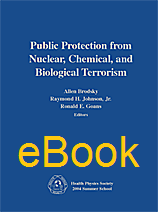
Public Protection From Nuclear, Chemical, and Biological Terrorism, eBook
Author: Allen Brodsky, Raymond H. Johnson, and Ronald E. Goans, editors (Health Physics Society)ISBN: 9781930524842
Published: 2004 July | 872 pp | eBook
Price: $ 65.00
Table of Contents
An Introduction to Terrorism
An Overview of NCRP Report No.138 on Terrorist Activities
Radiation Detection and Interdiction for Public Protection from Terrorism
Imaging and Identification Technologies for Homeland Security
Defining, Explaining, and Detecting Dirty Bombs
The Effects of Nuclear Weapons
Facts About Protection of Commercial Nuclear Power Reactors
Preparedness Resources Available Through the Department of Homeland Security's Office for Domestic Preparedness
Summary of Federal and State Resources for Recovery
Training Emergency Responders for Homeland Security
An Approach to First Responder Radiological Preparedness
Emergency Responder Training - A Mission Sensitive Approach
Combining Training Materials for Nuclear Fallout and Radioactivity Dispersing Devices (RDDs)
Eight Steps for Effective Emergency Responder Radiation Training
Radiation Instrument Training :Six Challenges for Emergency Responders
Experience with Federal and State Training Programs
Radiation Detection Instrument Standards for Homeland Security Applications
A Life-Cycle Approach for Development and Use of Emergency Response and Health Protection Instrumentation
Bioassay for Follow-up of Population Doses
Experience with Early Emergency Response and Rules of Thumb
Medical Lessons from International and U.S. Incidents
Local Emergency Response to Weapons of Mass Destruction in Rural and Frontier vs Urban Areas
General Considerations for Respiratory and Ventilation Protection Against Airborne Weapons of Mass Destruction
Guidance for Respiratory and Ventilation Protection Against Airborne Weapons of Mass Destruction
Hospital Responses to Radiation Casualties
Lessons Learned From a Criticality Accident: Applications to Homeland Security
The Environmental Protection Agency's Role in Radiological Dispersal Device Cleanup
Biodosimetry Tools Supporting the Recording of Medical Information During Radiation Casualty Incidents
Follow-up of Persons Exposed to Radiation and Radioactivity
Effects of Radiation In Combination with Biological or Chemical Warfare Agents
Rules of Thumb and Risks of Food and Water Contamination
How to Deal with Fears of Radiation and Nuclear Terrorism - Part I: Understanding the Fear Factor
How to Deal with Fears of Radiation and Nuclear Terrorism - Part II: Practical Tools for Effective
Radiation Risk Communication
Understanding and Managing the Psychological Impact of Weapons of Mass Destruction
Appendices
A.1: Guidance for Protective Actions Following a Radiological Terrorist Event
A.2: Medical Effects of Ionizing Radiation
A.3: Nuclear, Chemical, and Biological Terrorism:
Emergency Response and Public Protection
A.4: Effective Dose Coefficients for Selected Radionuclides
A.5: Gamma and Total Photon Exposure Rates for Point Sources
A.6: Simple Algorithms for Relating Surface Concentrations of Gamma Emitters to Exposure Rates for Circular and Rectangular Areas
A.7: Algorithms for Relating Surface Concentrations of Beta Emitters to Count Rates for Rectangular Detector Windows (or Cross Sections)
A.8: Algorithms for Calculating Fractions of Beta Particles Penetrating Through Various Mass Thicknesses to Tissue Depths or Sensitive Detector Volumes
A.9: Dosimetry Equation Summary
A.10: Miscellaneous Data for Rapid Dose Estimation and Planning
A.11: A National Registry to Expand Professional Effectiveness and Transition to Public Protection
A.12: Web Resources for Protection Against Weapons of Mass Destruction
A.13: Communicating with the Public and the Media


